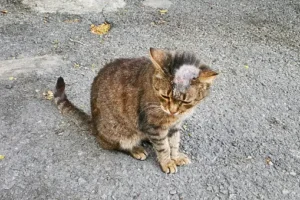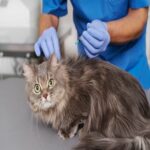Fungal infection in cats, also known as mycoses, can have various effects on their health and well-being. These infections are caused by different types of fungi, and their severity can vary depending on the specific fungus involved, the cat’s overall health, and the immune response. Here are 12 important effects of fungal infections in cats:

1. Skin Lesions:

Skin fungal infection in cats often manifest as skin lesions in cats. These can include circular patches of hair loss, redness, itching, crusting, and scaling.
2. Hair Loss:

Hair loss fungal infection in cats can cause localized or generalized hair loss in affected cats, leading to bald patches on the skin.
3. Pruritus (Itching):

Itching fungal infection in cats can cause intense itching, leading to scratching and self-trauma. This can worsen the skin lesions and increase the risk of secondary bacterial infections.
4. Respiratory Problems:

Certain fungal infection in cats such as Aspergillosis or Cryptococcosis, can be inhaled by cats and cause respiratory issues, including coughing, sneezing, and nasal discharge.
5. Eye Problems:

Fungal infection in cats like Cryptococcosis can affect a cat’s eyes, causing inflammation, redness, squinting, and possible vision impairment.
6. Ear Infections:

Fungal infection in cats can target a cat’s ears, leading to ear inflammation, wax buildup, and discomfort.
7. Digestive Issues:

Some fungal infection in cats can affect the digestive system, leading to symptoms such as vomiting, diarrhea, and reduced appetite.
8. Lameness and Joint Pain:

In certain cases, fungal infection in cats can affect bones and joints, causing lameness and pain in affected cats.
9. Central Nervous System (CNS) Involvement:
Severe fungal infection can sometimes spread to the central nervous system, leading to neurological symptoms like seizures, head tilting, and altered behavior.
10. Systemic Infection:
In immunocompromised cats or those with underlying health issues, fungal infections can become systemic, spreading throughout the body and affecting multiple organs. This can be life-threatening if left untreated.
11. Ringworm (Dermatophytosis):
This is the most frequent fungal infection in cats. Despite its name, ringworm is not caused by a worm but by different species of fungi, typically Microsporum canis or Trichophyton mentagrophytes. Ringworm can cause circular patches of hair loss with crusty and inflamed skin. It is also zoonotic, meaning it can be transmitted to humans.
12. Histoplasmosis:
Histoplasma capsulatum is the fungus responsible for this infection, and cats can get infected by inhaling spores from soil contaminated with bird or bat droppings. It typically affects the respiratory system and can cause generalized symptoms.
Must Visit: Why Grooming is essential for Pets
Must Visit: 8 General effects of calicivirus
It’s important to note that fungal infections in cats can vary significantly, and the symptoms described above may differ depending on the specific fungus involved and the individual cat’s response. If you suspect your cat has a fungal infection or notice any concerning symptoms, it’s essential to seek veterinary attention promptly for proper diagnosis and treatment. Early intervention can significantly improve the prognosis and prevent the infection from worsening.
symptoms:
The symptoms of fungal infections in cats can vary depending on the type of fungus and the organs affected. Common signs include skin lesions, hair loss, coughing, difficulty breathing, nasal discharge, sneezing, lethargy, and loss of appetite. If you suspect your cat may have a fungal infection, it’s essential to seek veterinary attention promptly.
Diagnosis:
Diagnosis usually involves skin scrapings, fungal cultures, blood tests, radiography, and sometimes biopsy of affected tissues. Treatment may include antifungal medications, which can vary depending on the specific fungus and the severity of the infection.
Preventing:
Preventing fungal infections in cats involves limiting their exposure to contaminated environments, keeping their living spaces clean, and seeking prompt veterinary care if any signs of infection are noticed. Additionally, practicing good hygiene and using appropriate antifungal agents can help protect both cats and humans from zoonotic fungal infections.
Must Visit: Amazing Top 15 birds with long beaks
Treatment:
The treatment of fungal infections in cats involves a combination of medication and supportive care. The most common fungal infections in cats are ringworm and Aspergillosis.
For ringworm, antifungal medications like griseofulvin, terbinafine, or itraconazole are typically prescribed. Topical treatments may also be applied to affected areas. Concurrently, environmental cleaning is essential to prevent spreading the infection to other pets or humans.
Aspergillosis is usually more severe and may require systemic antifungal medications such as voriconazole or itraconazole. The treatment duration can be lengthy and requires careful monitoring of the cat’s liver function as antifungal drugs can be hepatotoxic.
Throughout the treatment, it’s essential to ensure your cat’s immune system is supported with a balanced diet, stress reduction, and any necessary supportive care. Regular check-ups with the veterinarian are necessary to evaluate the cat’s progress and adjust the treatment plan if needed.
Prompt identification, early intervention, and consistent treatment adherence are crucial to successfully managing fungal infections in cats and preventing their spread to other animals or humans in the household. Always consult a veterinarian for accurate diagnosis and tailored treatment options for your cat’s specific condition.
Must Visit: How Rabies Virus effect Pets and Human
FAQ’s:
Q: How can I identify if my cat has a skin fungal infection?
Look for symptoms such as circular patches of hair loss, redness, itching, and scaling on your cat’s skin. The most common fungal infection in cats is ringworm, which may cause these characteristic lesions.
Q: Can my cat’s fungal infection spread to other pets or humans?
Yes, some skin fungal infections, like ringworm, are zoonotic, meaning they can be transmitted from animals to humans. It is crucial to isolate your cat, practice good hygiene, and seek medical attention if you suspect you or other family members may have been exposed.
Q: Can I treat my cat’s skin fungal infection at home?
It is not recommended to treat skin fungal infections in cats at home without professional guidance. Over-the-counter medications may not be effective or safe for cats.
Q: How are skin fungal infections in cats diagnosed?
Your veterinarian will likely perform a physical examination and may use a Woods lamp, which emits ultraviolet light to detect fluorescent particles in the hair shafts for ringworm diagnosis. Fungal cultures or skin biopsies may also be necessary for accurate identification.
Q: What is the typical duration of treatment for skin fungal infections in cats?
The treatment duration varies depending on the severity of the infection and the chosen antifungal medication. Regular follow-up visits with the veterinarian are essential to monitor progress and adjust the treatment plan as needed.
Must Visit: vetpomedix.com



Hiya, I am really glad I’ve found this info. Nowadays bloggers publish only about gossips and web and this is really annoying. A good site with interesting content, this is what I need. Thanks for keeping this site, I’ll be visiting it. Do you do newsletters? Cant find it.
I do enjoy the manner in which you have presented this issue plus it does offer me personally some fodder for thought. Nonetheless, from everything that I have witnessed, I just simply hope as other feedback stack on that individuals keep on point and don’t embark on a tirade of some other news du jour. Yet, thank you for this excellent piece and although I do not go along with it in totality, I respect your point of view.